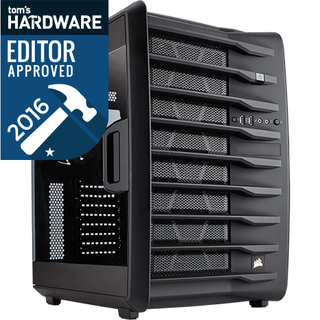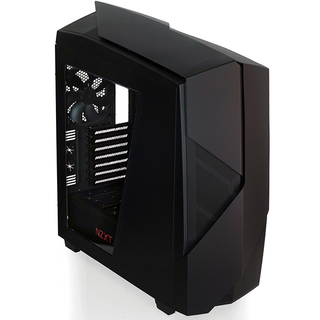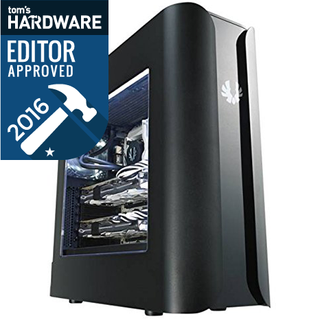Corsair Carbide Air 740 Extra-Wide ATX Gaming Tower Review
Why you can trust Tom's Hardware
Test Methods, Results, And Final Analysis
A little extra light shows that the Carbide Air 740’s side panel isn’t completely flat, but instead represents a reasonable approximation of flatness given that its material is plastic, rather than glass.

Test hardware and methods remain consistent from earlier reviews, and have been kept that way for over a year so that readers can compare data from any of our recently-tested mid-towers and full-towers.
The closest case in price, Rosewill’s Cullinan, is left out of today’s comparison due to its extensive use of more-expensive glass on an otherwise lower-market frame. The other “best matches” come from Corsair, but comparing other brands gives us a broader picture of the market. The Carbide Air 740’s less common layout leaves it competing against standard towers that target similar buyers only in price and front/top radiator support.
Test Results
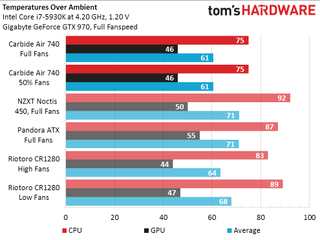
The first thing we notice in the Carbide Air 740’s cooling profile is its big lead against similarly-priced competitors. Other mid-towers that cool this effectively have included the Enthoo Evolv ATX Tempered Glass and Graphite 760T, which are both priced around $190.

The formula for better cooling usually involves louder fans and bigger holes, and the Carbide Air 740 sticks tenaciously to those rules. High “idle” noise at full fan speed proves that the Carbide Air 740’s fans are capable of making quite a ruckus on their own, while high “full load” noise at low case-fan speeds show that the Carbide Air 740 does a poor job of keeping in the noise of our graphics card.
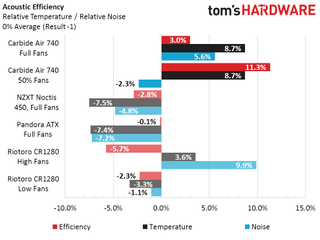
High cooling and relatively high noise both need to be examined with some perspective, and the most accurate way to compare noise to cooling is in a cooling-to-noise chart. Here we find that the somewhat-noisy Carbide Air 740 cools so well that it overwhelms in an Acoustic Efficiency chart.

The Carbide Air 740 costs only $10 more than the cases we compared, yet its performance lead over the Noctis 450 isn’t even large enough to win a full-speed to full-speed value analysis. On the other hand, the Carbide Air doesn’t need full speed to produce full cooling, and easily tops the Noctis 450 in both temperatures and value at that 50% setting. The Noctis 450 ran too hot to get a reasonable reading at low fans, leaving the Carbide Air 740’s 50% setting an uncontested value win among recently-tested, similarly-priced cases.
One thing we didn’t question was whether the Carbide Air 740 really is a $150 case, or whether any of the three competitors in today’s test are even worth $140. We can find reasons to say that each model should be cheaper. Additional radiator mounting space appears to be the primary reason for the Carbide Air 740’s side-by-side design, yet it doesn’t have a dust filter for its large bottom-panel radiator mount. It’s right side panel also feels mushy, almost like the manufacturer used less carbon in its steel. Logic dictates that this extra-wide design should use more material than its smaller or cheaper rivals, yet the $100 Micro ATX-based MasterCase Pro 3 actually weighs more. The question of how much case we’re actually getting for the money looms large even after considering its excellent drive mounts, enhanced internal volume, and overall performance benefits.
Weighing the Carbide Air 740’s few cheap traits against its enhanced performance and features, the relatively high price pushes its award level down a notch from “recommended” to “approved.”
MORE: Best Cases
MORE: All Case Content
MORE: In Pictures: 40 Unusual Computer Case Mods
- 1
- 2
Current page: Test Methods, Results, And Final Analysis
Prev Page Introducing The Carbide Air 740Stay on the Cutting Edge
Join the experts who read Tom's Hardware for the inside track on enthusiast PC tech news — and have for over 25 years. We'll send breaking news and in-depth reviews of CPUs, GPUs, AI, maker hardware and more straight to your inbox.
-
thundervore Corsair needs to go back to the drawing board.Reply
Who in their right mind would release a mid tower case that is this huge with only 2 front USB ports, no bottom intake dust filter, and the inability to support three 140mm fans in the front?
Talk about a waste of space and money. -
why_wolf uhh it does hold 3.5" drives as does the 540 and even the 240. I think what mean is it doesn't have a row of a half dozen or more 3.5" slots.Reply -
eridani64 I'm a former 540 owner and am glad I didn't wait for this one... took the plunge on a Thermaltake Core X9 and haven't looked back.Reply -
dstarr3 Man. No 5.25" bays and only three 3.5" bays. What's the point of such a huge case if you're not filling it with this stuff?Reply -
dstarr3 Reply18633545 said:I'm a former 540 owner and am glad I didn't wait for this one... took the plunge on a Thermaltake Core X9 and haven't looked back.
Wow, that case looks amazing. -
Crashman Reply
To begin with, the case is not huge in spite of how Corsair promotes it. It's about average mid-tower height, only a few inches wider, and not as deep as many mid-towers. Its volume resembles that of a classic (read, smaller) full tower.18632318 said:Corsair needs to go back to the drawing board.
Who in their right mind would release a mid tower case that is this huge with only 2 front USB ports, no bottom intake dust filter, and the inability to support three 140mm fans in the front?
Talk about a waste of space and money.
And it doesn't hold three 140's on front. They added a few inches so it could hold three 120s. They came up just shy of three 140s of space, though a modder could fit them by opening up the top of the front panel, into the space reserved for top/front radiator overlap.
-
thundervore Reply18634219 said:
To begin with, the case is not huge in spite of how Corsair promotes it. It's about average mid-tower height, only a few inches wider, and not as deep as many mid-towers. Its volume resembles that of a classic (read, smaller) full tower.18632318 said:Corsair needs to go back to the drawing board.
Who in their right mind would release a mid tower case that is this huge with only 2 front USB ports, no bottom intake dust filter, and the inability to support three 140mm fans in the front?
Talk about a waste of space and money.
And it doesn't hold three 140's on front. They added a few inches so it could hold three 120s. They came up just shy of three 140s of space, though a modder could fit them by opening up the top of the front panel, into the space reserved for top/front radiator overlap.
Ok, that's a great explanation about the lack of triple 140mm fans up front. What about only supplying 2 front USB ports and the lack of a bottom intake dust filter? -
Crashman Reply
That's why it didn't get a "Recommended" award :) It's only approved based on its performance and its ability to support two 2x140 and one 3x120 radiator simultaneously. That stamp of approval is meant to get buyers who want those specific things to take a closer look, but you don't think it's appropriate?18634263 said:18634219 said:
To begin with, the case is not huge in spite of how Corsair promotes it. It's about average mid-tower height, only a few inches wider, and not as deep as many mid-towers. Its volume resembles that of a classic (read, smaller) full tower.18632318 said:Corsair needs to go back to the drawing board.
Who in their right mind would release a mid tower case that is this huge with only 2 front USB ports, no bottom intake dust filter, and the inability to support three 140mm fans in the front?
Talk about a waste of space and money.
And it doesn't hold three 140's on front. They added a few inches so it could hold three 120s. They came up just shy of three 140s of space, though a modder could fit them by opening up the top of the front panel, into the space reserved for top/front radiator overlap.
Ok, that's a great explanation about the lack of triple 140mm fans up front. What about only supplying 2 front USB ports and the lack of a bottom intake dust filter?
